BLACK KITE PROJECT
Question- How have black kites responded to vulture declines in the Indian Subcontinent?
We addressed this question using quantitative data on the density, nest spacing, phenology, breeding success and diet of a fully urban population of kites in Delhi. During 2013-14 Black Kite nests were surveyed in 24 plots of 1 km2 distributed throughout Delhi. Sample of 151 nests regularly checked to record laying date, breeding success and diet. At 20 nests/km2, the density of Black Kites in Delhi may represent the highest concentration of a raptor recorded in the world and has not declined since the 1960s. This is probably promoted by a combination of (i) availability of organic remains, (ii) few predators and (iii) high tolerance by people.
Details in: Nishant Kumar, Dhananjai Mohan, Yadvendradev V. Jhala, Qamar Qureshi & Fabrizio Sergio (2014) Density, laying date, breeding success and diet of Black Kites Milvus migrans govinda in the city of Delhi (India), Bird Study, 61:1, 1-8, DOI: 10.1080/00063657.2013.876972 (open access)
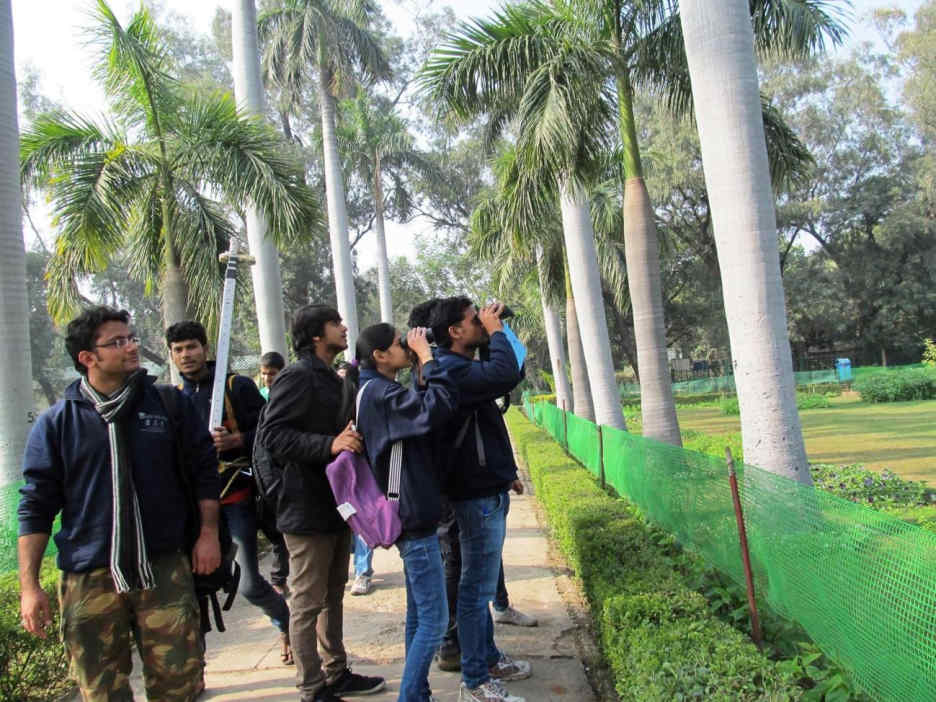 Black Kite project team at North Campus, Delhi University, sampling site (Phase I, February 2014). In the picture (left to right): Dr. Nishant Kumar, Laxmi Narayan, Rajat Rastogi, Urvi Gupta and Shakti Prajapati.
Black Kite project team at North Campus, Delhi University, sampling site (Phase I, February 2014). In the picture (left to right): Dr. Nishant Kumar, Laxmi Narayan, Rajat Rastogi, Urvi Gupta and Shakti Prajapati.
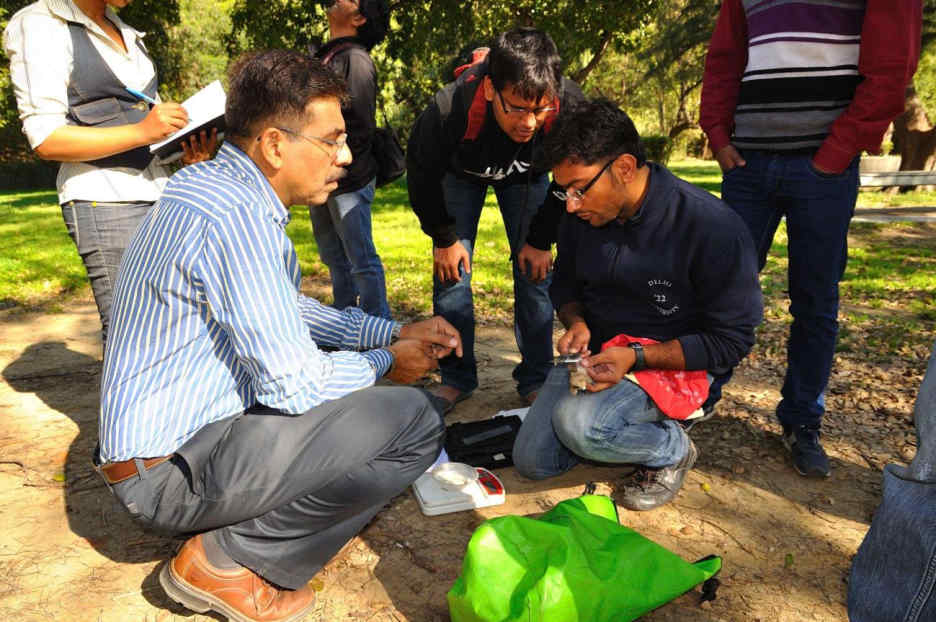 Prof. Y V Jhala overlooks the morphometric measurements of a hatchling at the National Zoological Park, Delhi. In the picture: Dr Nishant Kumar, Avinash Yadav, and other team members
Prof. Y V Jhala overlooks the morphometric measurements of a hatchling at the National Zoological Park, Delhi. In the picture: Dr Nishant Kumar, Avinash Yadav, and other team members
 Prof. Qamar Qureshi addressing the team members near Ghazipur landfill as Dr Alessandro Tanferrna (CSIC, Spain) looks on (Chicken market).
Prof. Qamar Qureshi addressing the team members near Ghazipur landfill as Dr Alessandro Tanferrna (CSIC, Spain) looks on (Chicken market).
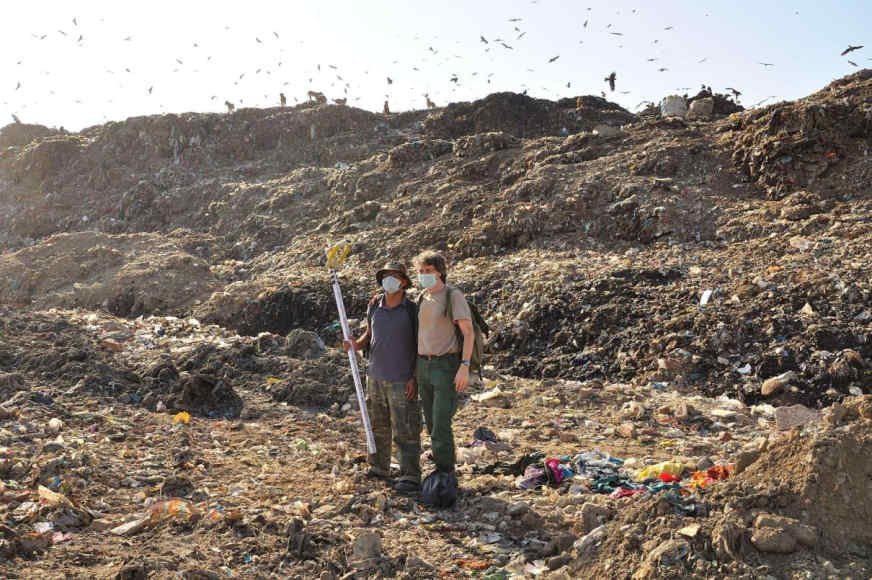 Dr. Nishant Kumar and Prof. Fabrizio Sergio atop Ghazipur landfill (February 2013).
Dr. Nishant Kumar and Prof. Fabrizio Sergio atop Ghazipur landfill (February 2013).
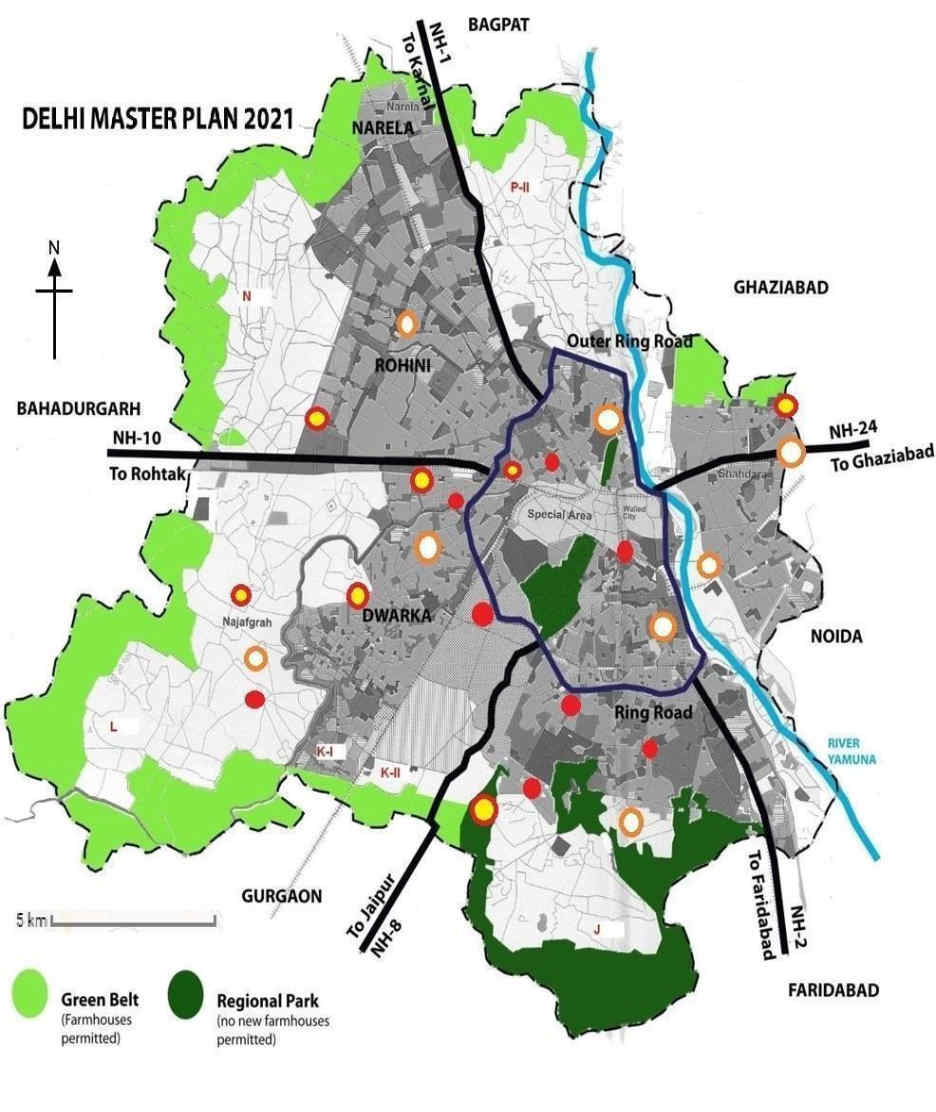 Delhi Master plan map 2021 (source: Municipal Corporation of Delhi), with the sampling units (the larger bi-colour dots depict the sampling units followed each year to monitor annual variations). [Image Credit: Delhi Master Plan; Delhi Development Authority]
Delhi Master plan map 2021 (source: Municipal Corporation of Delhi), with the sampling units (the larger bi-colour dots depict the sampling units followed each year to monitor annual variations). [Image Credit: Delhi Master Plan; Delhi Development Authority]
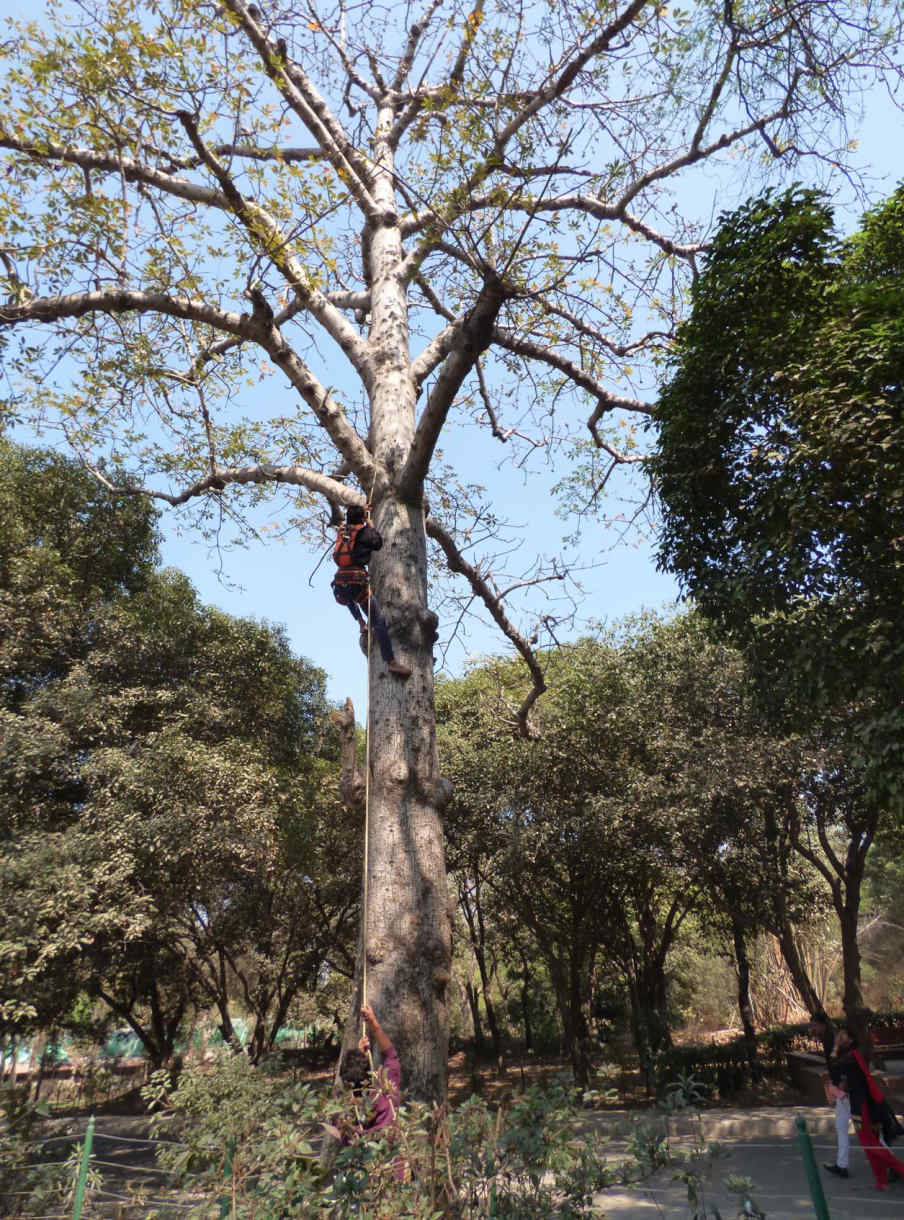 On an average, a Black Kite nest stands at the height of about 10 - 12m
On an average, a Black Kite nest stands at the height of about 10 - 12m
Question- Which human and environmental factors in a heterogeneously developed tropical megacity govern the selection of nesting habitat by Black Kites at the micro (nest) and landscape scales?
A typical way to determine such selection criteria is a comparison of actual nest locations (154) within the 24 sampling study plots, with a matching number of locations randomly chosen by a computer program (ArcGIS, a computer program for geographic analysis, i.e., Geographic Information System). This statistical comparison revealed that kites were not randomly distributed in the city but over-selected areas with high human density, poor waste management and a road configuration that facilitated ready access to resources provided by humans. These individual-level preferences translated into population-level effects, with kite density tightly tied to ritual meat tossing subsidies in older establishments of the city. This relationship was further modulated by nest-site availability, mainly in the form of urban woodland availability in small and large parks, from where food subsidies can easily be accessed.
Details in: Nishant Kumar, Urvi Gupta, Yadvendradev V. Jhala, Qamar Qureshi, Andrew G Gosler & Fabrizio Sergio (2018) Habitat Selection by an Avian Top Predator in the Tropical Megacity of Delhi: Human Activities and Socio-religious Practices as Prey-facilitating Tools, Urban Ecosystems, 21,
Pages 339–349: https://link.springer.com/article/10.1007/s11252-017-0716-8.
Fabrizio Sergio, G Tavecchia, A Tanferna, L López Jiménez, J Blas, R De Stephanis, T A Marchant, Nishant Kumar, F Hiraldo (2015) No effect of satellite tagging on survival, recruitment, longevity, productivity and social dominance of a raptor, and the provisioning and condition of its offspring, Journal of Applied Ecology, 52 (6):1665–1675. https://besjournals.onlinelibrary.wiley.com/doi/full/10.1111/1365-2664.12520
Nishant Kumar, Urvi Gupta, Yadvendradev V. Jhala, Qamar Qureshi, Andrew G Gosler & Fabrizio Sergio (2020) Cities: How do some birds thrive there?, Frontiers for Young Minds, Open access: https://kids.frontiersin.org/articles/10.3389/frym.2020.00046
 A schematic depiction of Habitation selection criteria of breeding kites in Delhi that involves optimal use of woodlands or parklands near mosques. It enables kite breeders to opportunistically capitalise over ritually-tossed meat. [Credit: Frontiers for Young Minds]
A schematic depiction of Habitation selection criteria of breeding kites in Delhi that involves optimal use of woodlands or parklands near mosques. It enables kite breeders to opportunistically capitalise over ritually-tossed meat. [Credit: Frontiers for Young Minds]
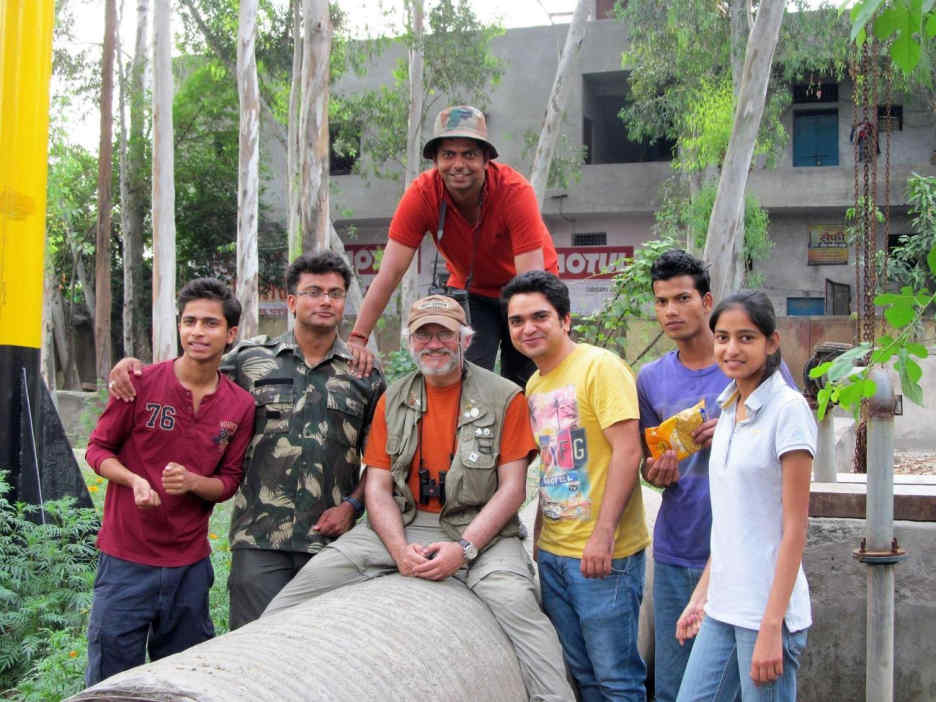 Research Team with Prof Andrew G Gosler at Mangolpuri, New Delhi. In the picture, from left to right: Mukesh Singh, Dr. Nishant Kumar, Prof Andrew Gosler, Prashant Kumar, Avinash Kumar Azad, Laxmi Narayan, Urvi Gupta
Research Team with Prof Andrew G Gosler at Mangolpuri, New Delhi. In the picture, from left to right: Mukesh Singh, Dr. Nishant Kumar, Prof Andrew Gosler, Prashant Kumar, Avinash Kumar Azad, Laxmi Narayan, Urvi Gupta
Question- Which of the nest, human and environmental factors explain variations in the nest defense against humans within and across the sampling units?
Is there any payoff for the choice of aggressive nest defense by parent kites?
Can human and environmental factors, e.g., local architecture, predict the likelihood of aggressive offspring defense by a breeding kite-pair?
What socio-cultural factors govern the coexistence of breeding kites in cities like Delhi, where birds nesting close to humans aggressively defend their offspring?
A behaviour very peculiar for the breeding kites in Delhi – given that kites in Europe are not known to exhibit aggression to humans – was aggressive offspring defense against people who frequented their nests/gazed at the nesting tree within 20 m. However, this behaviour was not uniform and we recorded variations in the levels of aggression, both, within and across sampling units and along the breeding cycle. We expected the criteria of resource selection in the city to affect the investment in offspring defense by a breeding pair. Considering that such human-kite aggressions can affect the coexistence, it was necessary to examine what promoted mutual tolerance. In particular, offspring defence was finely-tuned on human subsidies, probably as a result of the associated parental investments and familiarity with humans. Here, humans (research team as well as residents around the nests) were a surrogate to test variations in parental investment to imminent threats by potential nest predators. The analysis also found fitness consequences of investment in aggressive defence by parent birds.
In its most extreme form, offspring defence led to attacks on humans, sometimes with physical harm. We showed that such aggression was tied to frequent exposure to humans by kites while accessing their ritual subsidies and by constant close proximity to them while breeding, as caused by local architecture (balconies in the immediate proximity of nests). Despite the conflict, we also reported the extremely benevolent attitudes of local people to the attacking kites, typical of southern-Asian cultural beliefs, but extremely unusual for western urban standards
Details in: Nishant Kumar, Qamar Qureshi, Yadvendradev V. Jhala, Andrew G Gosler & Fabrizio Sergio (2018) Offspring defense by an urban raptor responds to human subsidies and ritual animal-feeding practices, PLoS ONE, https://doi.org/10.1371/journal.pone.0204549
Nishant Kumar, Yadvendradev V. Jhala, Qamar Qureshi, Andrew G Gosler & Fabrizio Sergio (2019) Human-attacks by an urban raptor are tied to human subsidies and religious practices, Scientific Reports, https://www.nature.com/articles/s41598-019-38662-z
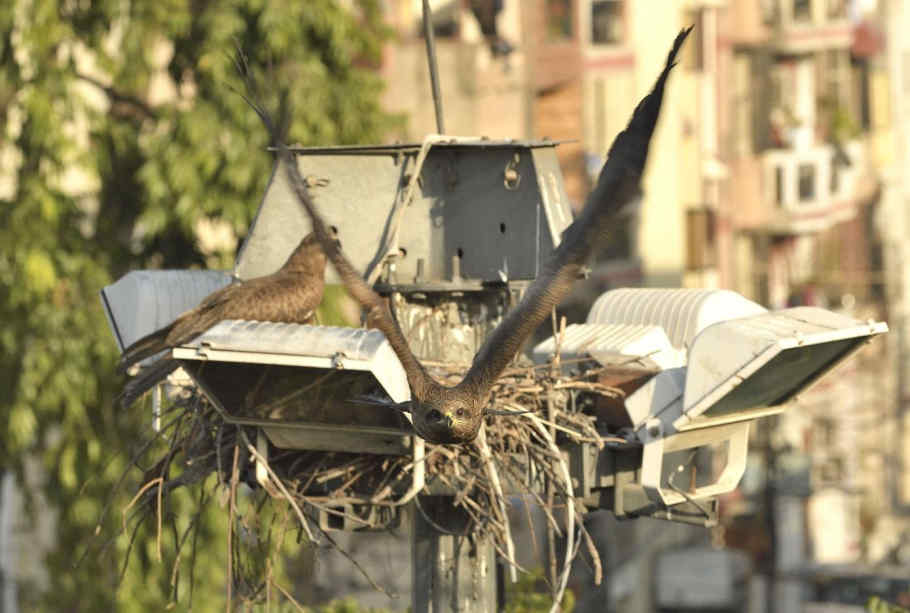
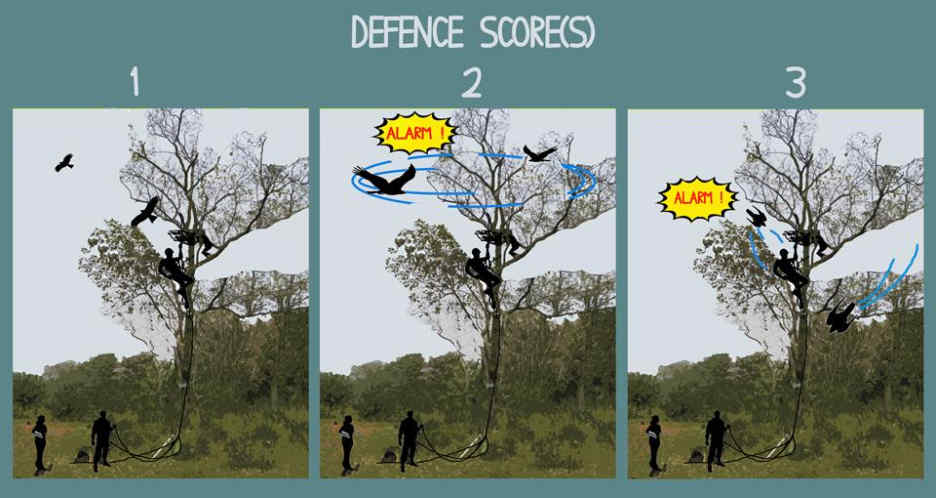 Cost to defend
Cost to defend
Black kite takes off from its nest on a pylon to attack the photographer, who is standing on a balcony (Photo credit: F. Sergio).
Question- Out of the breeding/non-breeding birds, which kites form stunning flocks over landfills in Delhi?
Deployment of a GPS transmitter donated by Prof Fabrizio Sergio in April 2014 revealed that stunning predator densities observed in Delhi are not only generated by the local breeding subspecies, but also by thousands of Black-eared Kites of the migratory M. m. lineatus subspecies. These birds settle on or near the garbage/landfills in 100s of cities like Delhi in the South and South-East Asia during their wintering, non-breeding period. Through further GPS-tagging, courtesy Christian Howey Raising Scholar Award to Dr Nishant Kumar and the Phase IV grant from RRCF, we found that they migrate to Delhi from their breeding quarters of Russia, Kazakhstan, Xinxiang (China) and Mongolia through a 3300-4700 km migration that is completed in three to four weeks at a speed of ~ 200 km/day. During this arduous migratory journey, kites regularly cross the Himalaya range at elevations of up to 5000-6000 m a.s.l., an aspect hitherto unknown. They were observed to cross Himalayas at the height of K2, and cross the Taklamakan Desert as well.
Details in: Nishant Kumar, Urvi Gupta, Yadvendradev V. Jhala, Qamar Qureshi, Andrew G Gosler & Fabrizio Sergio (2019) GPS-telemetry unveils the regular high-elevation crossing of the Himalayas by a migratory raptor: implications for definition of a "Central Asian Flyway", Scientific Reports, https://www.nature.com/articles/s41598-020-72970-z
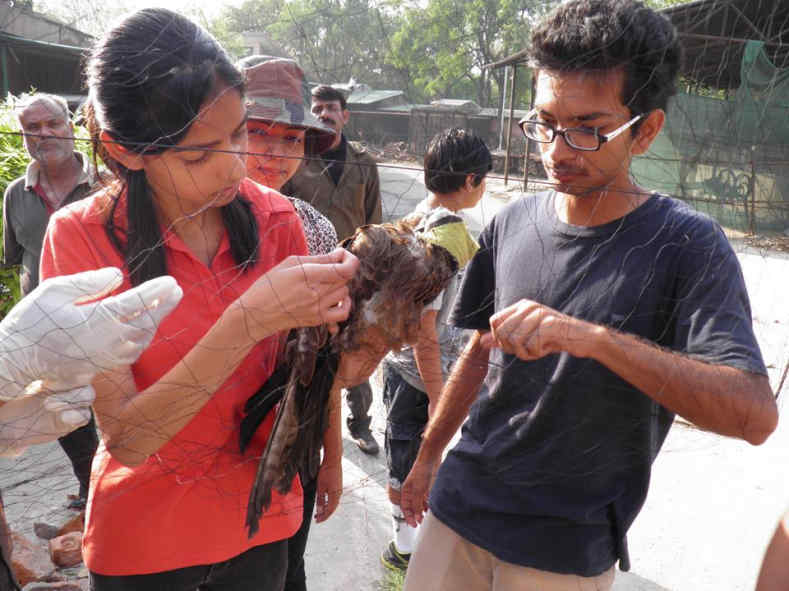
 Trapping a kite using mist-net to affix a on it, a GPS PTT using a teflon backpack harness
Trapping a kite using mist-net to affix a on it, a GPS PTT using a teflon backpack harness

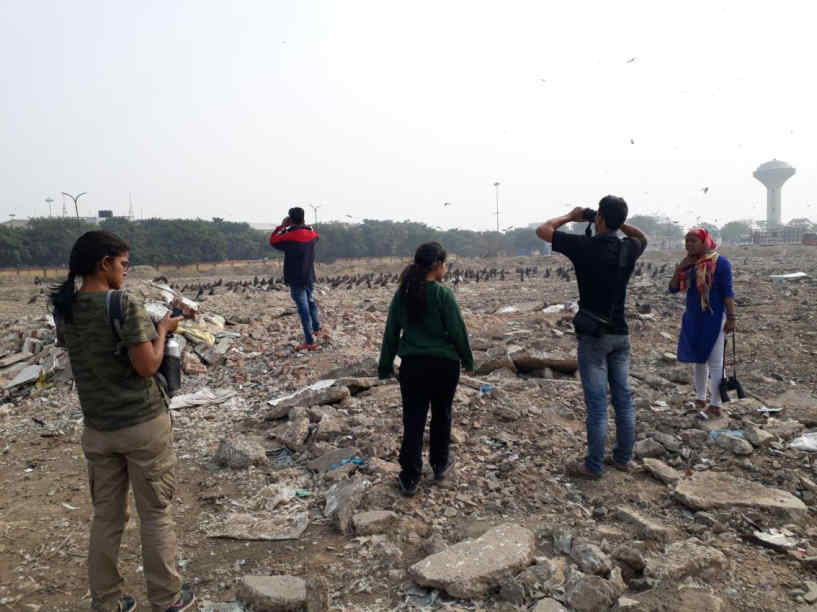 The Black Kite Project team banding the fledglings and surveying the field sites for tagged birds
The Black Kite Project team banding the fledglings and surveying the field sites for tagged birds
 Pre-breeding (blue tracks) and post-breeding (red tracks) migration routes, and breeding and non-breeding ranges (pink polygons) of Black-eared kites Milvus migrans lineatus GPS-tagged in Delhi (India). The broken red line connects the likely breeding and wintering locations of a lineatus kite, based on a ring recovery in North-East India, bordering Myanmar. his map was generated with ArcGIS 10.5, using World Imagery by Esri, Maxar, GeoEye, Earthstar Geographics, CNES/Airbus DS, USDA, USGS, AeroGRID, IGN and the GIS User Community
Pre-breeding (blue tracks) and post-breeding (red tracks) migration routes, and breeding and non-breeding ranges (pink polygons) of Black-eared kites Milvus migrans lineatus GPS-tagged in Delhi (India). The broken red line connects the likely breeding and wintering locations of a lineatus kite, based on a ring recovery in North-East India, bordering Myanmar. his map was generated with ArcGIS 10.5, using World Imagery by Esri, Maxar, GeoEye, Earthstar Geographics, CNES/Airbus DS, USDA, USGS, AeroGRID, IGN and the GIS User Community

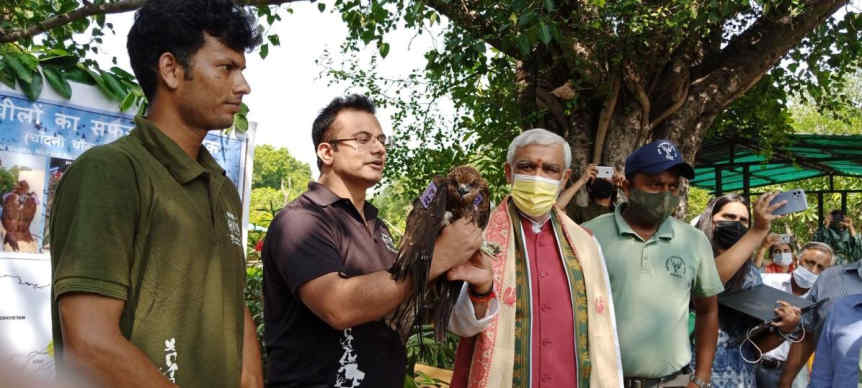 On the occasion of Wildlife Week Celebration in October 2021 at the National Zoological Park, Delhi, Shri Ashwini Kumar Choubey, Minister of State for Environment, Forest and Climate Change (MoEFCC) Government of India released a tagged Black-eared kite.
On the occasion of Wildlife Week Celebration in October 2021 at the National Zoological Park, Delhi, Shri Ashwini Kumar Choubey, Minister of State for Environment, Forest and Climate Change (MoEFCC) Government of India released a tagged Black-eared kite.
Question- Which human and environmental factors in a heterogeneously developed tropical megacity govern the spatial variation in population density of breeding units of black kites?
The impact of culture, e.g. providing food subsidies was evident in individual-level preferences, which translated into population-level effects, with kite density tightly tied to Muslim subsidies. This relationship was further modulated by nest-site availability, mainly in the form of tree availability, which paved the way to potential population-manipulation through tree management. Similar ties between animal population densities, key anthropogenic resources and human beliefs may occur in thousands of cities all over the globe and may fit poorly with our current understanding of urban ecosystem functioning. Ecological responses were accompanied and mediated by behavioural adjustments to the urban gradient, which not only provided adaptive benefits but also generated potential conflicts with humans
Details in:Nishant Kumar, Urvi Gupta, Harsha Malhotra, Yadvendradev V. Jhala, Qamar Qureshi, Andrew G Gosler & Fabrizio Sergio (2019) The population density of an urban raptor is inextricably tied to human cultural practices, Proceedings of the Royal Society B: Biological Sciences, https://doi.org/10.1098/rspb.2018.2932
Nishant Kumar, Aparajita Singh, and Barbara Harriss-White. (2019). Urban Waste and the Human-Animal Interface in Delhi, Economic and Political Weekly, 54 (47). https://www.epw.in/journal/2019/47/review-urban-affairs/urban-waste–human-animal-interface-delhi.html
 The Black kites of Delhi depend heavily on human subsidies offered for religious reasons: (a) a man with his two sons ritually feeds kites with the typical, compact chunks of red meat (red circle); (b) large numbers of kites, sometimes into the hundreds, may congregate at such feeding events; (c) the ritual offerings are taken to the nests; (d) a parent kite is about to feed its fledgling with a ritual meat chunk. More than 90 % of the diet in this population is composed of ritual offerings, which explains the tight link between breeding density and ready access to human cultural subsidies (Photo credit for all images: F. Sergio).
The Black kites of Delhi depend heavily on human subsidies offered for religious reasons: (a) a man with his two sons ritually feeds kites with the typical, compact chunks of red meat (red circle); (b) large numbers of kites, sometimes into the hundreds, may congregate at such feeding events; (c) the ritual offerings are taken to the nests; (d) a parent kite is about to feed its fledgling with a ritual meat chunk. More than 90 % of the diet in this population is composed of ritual offerings, which explains the tight link between breeding density and ready access to human cultural subsidies (Photo credit for all images: F. Sergio).

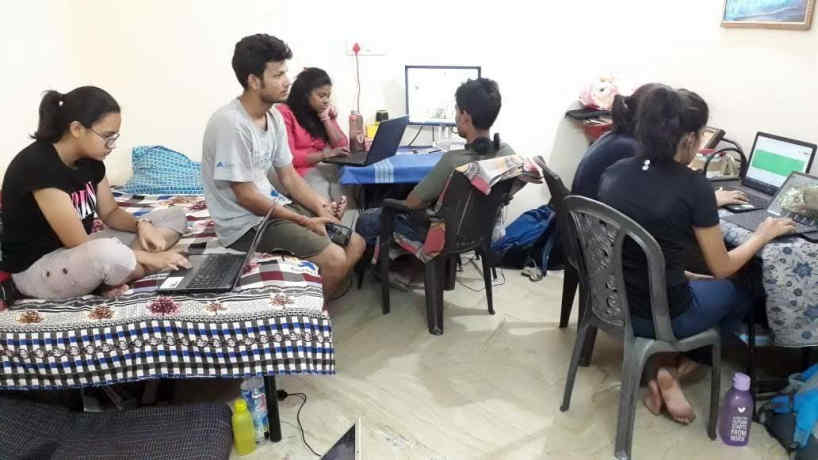 After the arduous efforts on data collection through the breeding season, the team works at the base from June – September every year, curating data from the millions of images obtained from trail cameras and other sources
After the arduous efforts on data collection through the breeding season, the team works at the base from June – September every year, curating data from the millions of images obtained from trail cameras and other sources
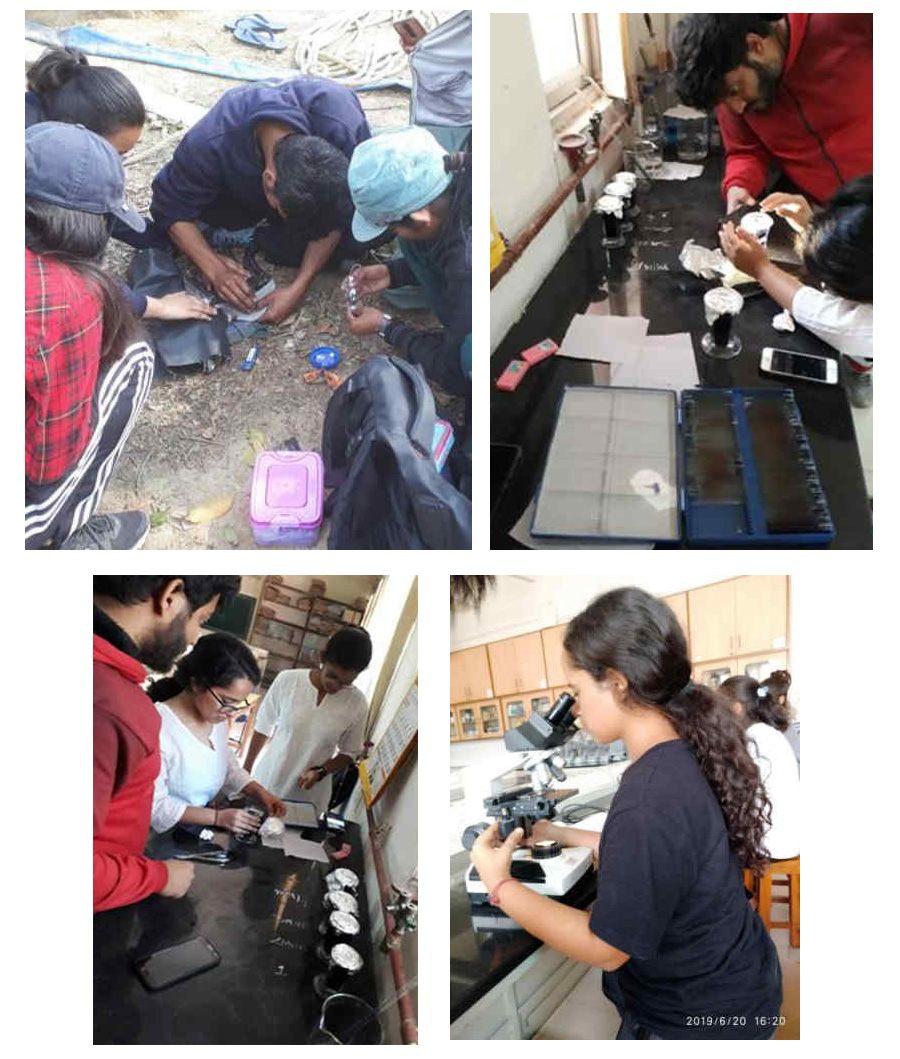 Preparation, fixation, staining and examination of slides for histopathological analyses at Sri Venkateswara College, Delhi University
Preparation, fixation, staining and examination of slides for histopathological analyses at Sri Venkateswara College, Delhi University
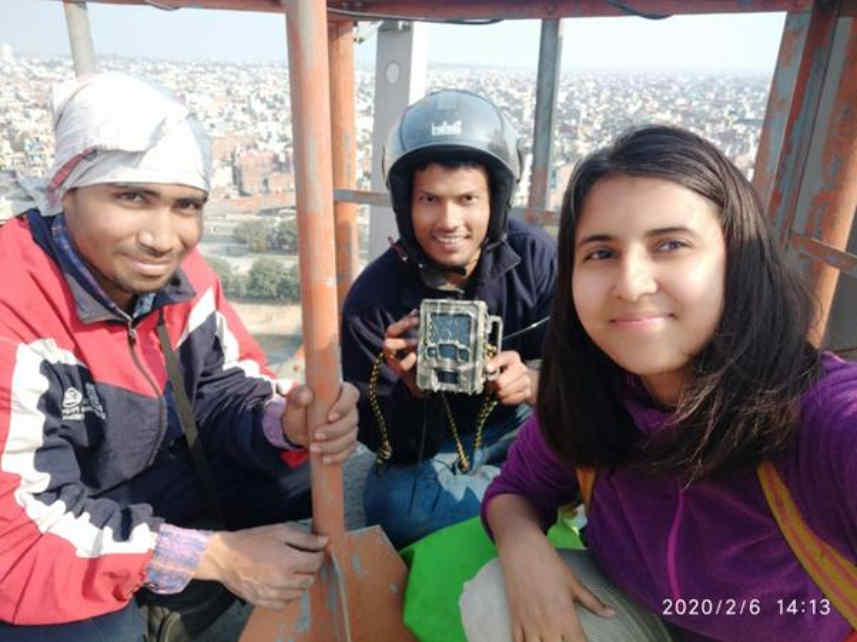
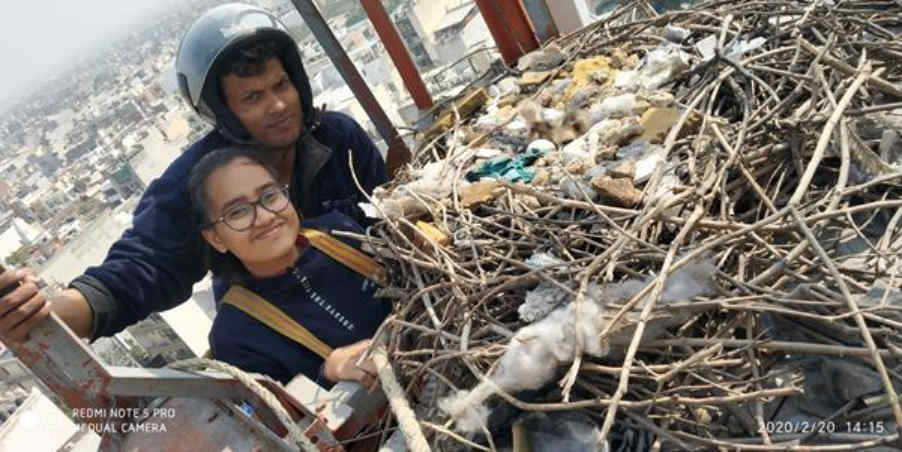 A view from a kite’s nest: the arduous efforts to fix trail cameras to collect millions of pictures in each breeding season, to remotely monitor the nests 24 X 7
A view from a kite’s nest: the arduous efforts to fix trail cameras to collect millions of pictures in each breeding season, to remotely monitor the nests 24 X 7
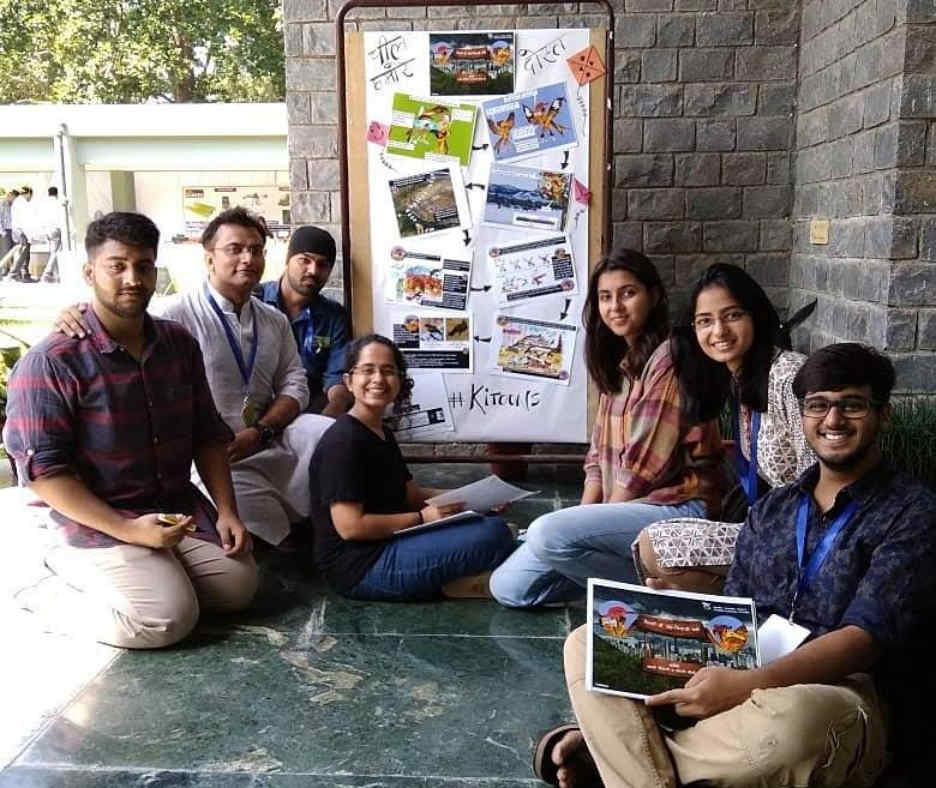 Black Kite Project Team at WII during the Annual Research Seminar- 2018, for the official release of the Kitoon- I, based on the first two research manuscripts
Black Kite Project Team at WII during the Annual Research Seminar- 2018, for the official release of the Kitoon- I, based on the first two research manuscripts
Question - How do the two kite races in the Indian Subcontinent partition the urban resources?
What factors govern the choice of breeding/roosting territories by the individuals of the two subspecies?
What is the impact on diet richness on the chicks’ physiological status and growth?
What is the impact of subsisting in urban habitat (in terms of stress) on the breeding success of a nesting territory?
How do the ectoparasite and blood parasite loads vary for the two kite races along the urban gradient?
An important objective of Phase-V that got affected due to the COVID-19 lockdown was understanding movement ecology and parental behaviour using GPS telemetry to study (i) how resident kites move and forage within the city, and (ii) how they select foraging sites and its variation along the urban gradient. With an anticipation for sufficient contemporaneous telemetry data, we expected to examine how the two subspecies of kites that occur sympatrically in Delhi during October-March, may differentially exploit the urban environment. This exercise will provide theoretical insights into resource partitioning between potential competitors.
The researchers will associate: a. nesting success b. migratory-success and c. survivorship as a function of these aforementioned interactions, coupled with the (i) movement and tri-axial accelerometer data (from the PTTs) that is an index of metabolic-parameters, (ii) environmental factors at the nest and landscape scale (Kumar et al. 2018a), and (iii) the human-factors (Kumar et al. 2018a, 2019b) as predictors. Research efforts during Phase-VI would illustrate and link patterns behind life history traits shaped for urban residency (wintering as well as resident-breeding status).
In order to put local perspectives on kite research for the phylogeography of the extant Milvinae kite subspecies they will also conduct genomic studies. Several published studies on phylogenetic and phylogeographic relationships between the seven subspecies of kites found across the old world and Australasia could not include enough samples from the Indian sub-continent. With the tissue samples the team we have collected from the govinda as well as lineatus kites, the genetic analysis will not only fill this important aforementioned gap, but will also shed some light over the existing contention on competing theories that support either tropical home or temperate home hypotheses, in terms of the origin of migratory or resident (breeding) status of bird populations. To accomplish this objective, they recently extended collaborations with the team of Dr Nyambayar Batbayar, based in Mongolia. Since 2016, Dr Batbayar and colleagues have been deploying PTTs on multiple migratory raptor species (e.g. Black-eared Kites and Steppe-eagles) in Mongolia, China and Nepal.
Details in:Sumasgutner, Petra, Ralph Buij, Christopher J W McClure, Phil Shaw, Cheryl R Dykstra, Nishant Kumar, and Christian Rutz. 2021. "Raptor Research during the COVID-19 Pandemic Provides Invaluable Opportunities for Conservation Biology." Biological Conservation, 109149. https://doi.org/https://doi.org/10.1016/j.biocon.2021.109149

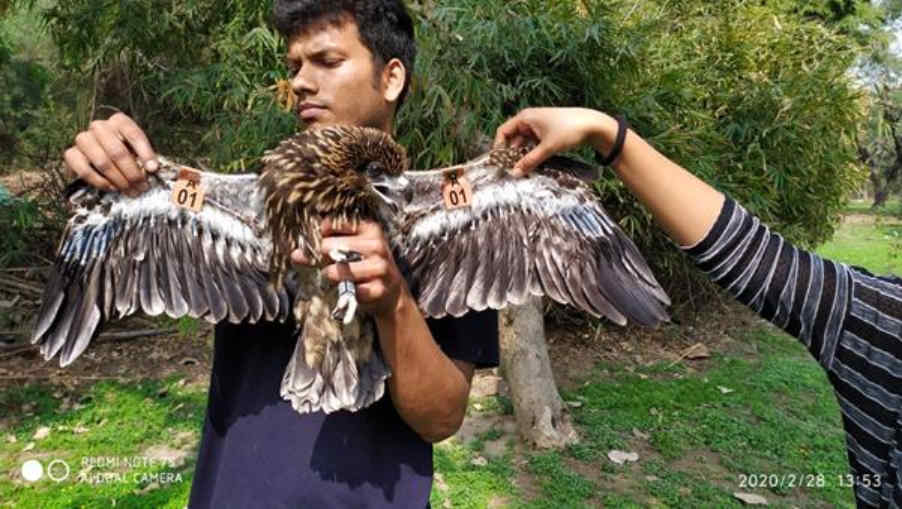 From the 2019-2020 breeding season, we started deploying patagial tags with unique alpha-numeric code, and colour for each year would allow us to sample this population to study the factors that impact survivorship post fledging
From the 2019-2020 breeding season, we started deploying patagial tags with unique alpha-numeric code, and colour for each year would allow us to sample this population to study the factors that impact survivorship post fledging

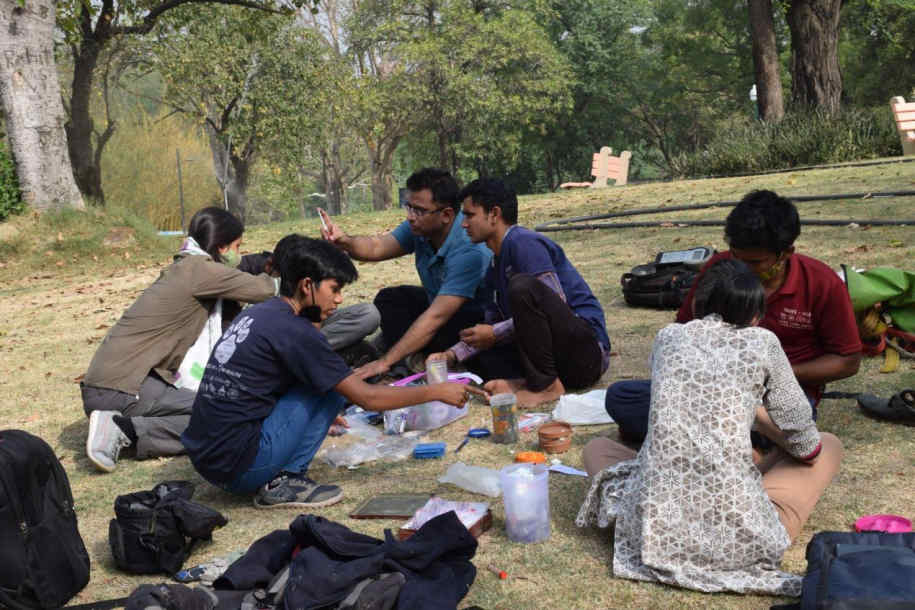 Field team processing a resident Black Kite while affixing a GPS platform terminal transmitter
Field team processing a resident Black Kite while affixing a GPS platform terminal transmitter
Outreach, Awareness and Capacity Building
Alongside, with the team of volunteers, researchers have also imparted conservation education to more than 60,000 Delhi citizens, as a mobile conservation education unit through the last 9 years of field research. Additionally, they have voluntarily lectured in 6 schools and 8 colleges, and ran a workshop at the Miranda House, Delhi University led by Ms Urvi Gupta, for the Department of Science & Technology, Govt. Of India’s initiative INSPIRE. Since 2012, the team have also trained >160 university students on basic field research. A lot of them have joined institutions of national and international repute for their higher studies and career progression (Oxford University UK, Imperial College London, University of Dublin, Northern Ireland University Galway, Wildlife Institute of India and Forest Research Institute Dehradun, Jawaharlal Nehru Centre for Advanced Scientific Research, Bangalore, The Energy and Resources Institute and Delhi University, Wildlife Conservation Society, State Forest Departments etc).
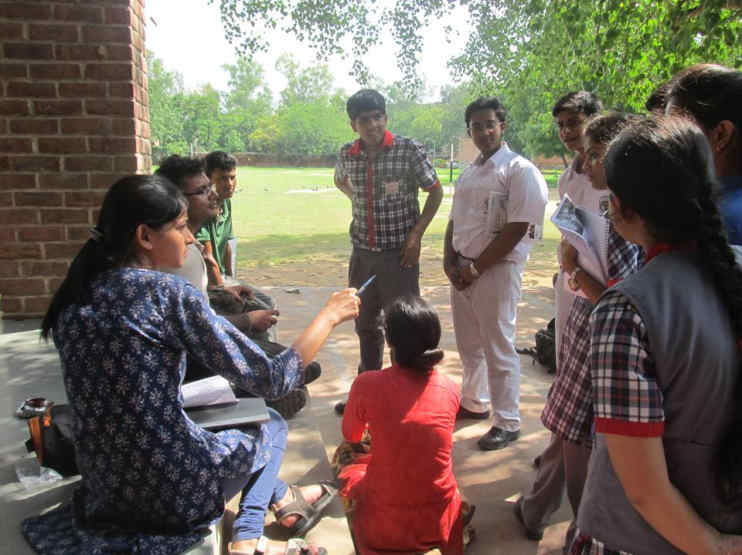
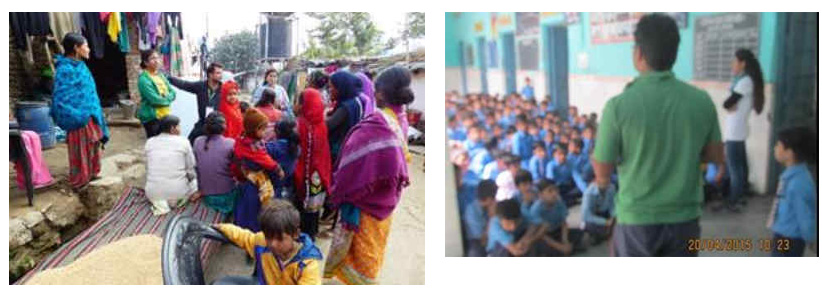
Peer Reviewed Publications
- Kumar N. 2022. The Conference of the Birds and people in tropical cities. Ashmolean Museum. University of Oxford. UK.
- Sumasgutner, Petra, Ralph Buij, Christopher J W McClure, Phil Shaw, Cheryl R Dykstra, Nishant Kumar, and Christian Rutz. 2021. "Raptor Research during the COVID-19 Pandemic Provides Invaluable Opportunities for Conservation Biology." Biological Conservation, 109149. https://doi.org/https://doi.org/10.1016/j.biocon.2021.109149
- Kumar, Nishant, Urvi Gupta, Yadvendradev V Jhala, Qamar Qureshi, Andrew G Gosler, and Fabrizio Sergio. 2020. "GPS-Telemetry Unveils the Regular High-Elevation Crossing of the Himalayas by a Migratory Raptor: Implications for Definition of a ‘Central Asian Flyway.’" Scientific Reports 10 (1): 1–9.
- Kumar, Nishant, Urvi Gupta, Yadvendradev V. Jhala, Qamar Qureshi, Andrew Gosler, and Fabrizio Sergio. 2020. "Cities: how do some birds thrive there?." Frontiers for Young Minds, 8:46. https://doi.org/10.3389/frym.2020.00046
- Kumar, Nishant, Urvi Gupta, Harsha Malhotra, Yadvendradev V. Jhala, Qamar Qureshi, Andrew G. Gosler, and Fabrizio Sergio. 2019. "The Population Density of an Urban Raptor Is Inextricably Tied to Human Cultural Practices." Proceedings of the Royal Society B: Biological Sciences 286 (1900). https://doi.org/10.1098/rspb.2018.2932.
- Kumar, Nishant, Aparajita Singh, and Barbara Harriss-White. 2019. "Urban Waste and the Human-Animal Interface in Delhi." Economic and Political Weekly 54 (47).
- Kumar, Nishant, Yadvendradev V Jhala, Qamar Qureshi, Andrew G Gosler, and Fabrizio Sergio. 2019. "Human-Attacks by an Urban Raptor Are Tied to Human Subsidies and Religious Practices." Scientific Reports 9 (1): 2545. https://doi.org/10.1038/s41598-019-38662-z.
- Kumar, Nishant, Qamar Qureshi, Yadvendradev V Jhala, Andrew G Gosler, and Fabrizio Sergio. 2018. "Offspring Defense by an Urban Raptor Responds to Human Subsidies and Ritual Animal-Feeding Practices." PloS One 13 (10): e0204549.
- Kumar, Nishant, Urvi Gupta, Yadvendradev V Jhala, Qamar Qureshi, Andrew G Gosler, and Fabrizio Sergio. 2018. "Habitat Selection by an Avian Top Predator in the Tropical Megacity of Delhi: Human Activities and Socio-Religious Practices as Prey-Facilitating Tools." Urban Ecosystems 21 (2): 339–49. https://doi.org/10.1007/s11252-017-0716-8.
- Fabrizio Sergio, G Tavecchia, A Tanferna, L López Jiménez, J Blas, R De Stephanis, T A Marchant, Nishant Kumar, F Hiraldo (2015) No effect of satellite tagging on survival, recruitment, longevity, productivity and social dominance of a raptor, and the provisioning and condition of its offspring, Journal of Applied Ecology, 52 (6):1665–1675. https://besjournals.onlinelibrary.wiley.com/doi/full/10.1111/1365-2664.12520
- Kumar, Nishant, Dhananjai Mohan, Yadvendradev V Jhala, Qamar Qureshi, and Fabrizio Sergio. 2014. "Density, Laying Date, Breeding Success and Diet of Black Kites Milvus migrans govinda in the City of Delhi (India)." Bird Study 61 (1): 1–8.
Popular Booklets & Articles
Kumar N, Taneja Y, Kalita M, Gupta U .2018. [English] Our feathered co-inhabitants of Delhi: coexisting migrant and resident Black Kite races in a developing megacity, Wildlife Institute of India, Dehradun.
Kumar N, Taneja Y, Kalita M, Gupta U .2018. [Hindi] Our feathered co-inhabitants of Delhi: coexisting migrant and resident Black Kite races in a developing megacity, Wildlife Institute of India, Dehradun.
Urvi Gupta & Singh, H. (2017) "Urban Ecology and Biodiversity Conservation" Imprint- Zoology Magazine for St. Xaviers College, Mumbai
Media Coverage (Phase I -VI: 2012-2021)
- Dainik Jagran. हर साल 10 हजार विदेशी और भारतीय चीलें दिल्ली का 4000 टन कचरा करती हैं साफ: https://www.jagran.com/uttar-pradesh/aligarh-city-every-year-4000-tons-of-garbage-in-delhi-are-cleaned-by-eagle-jagran-special-19756068.html
- Indian Express. In Faridabad village, a dead bird, a GPS tag and cross-border fears: https://indianexpress.com/article/india/in-faridabad-village-a-dead-bird-a-gps-tag-and-cross-border-fears-5614590
- The Hindu. For Delhi’s black kites, it’s a trade-off. https://www.thehindu.com/sci-tech/energy-and-environment/for-delhis-black-kites-its-a-trade-off/article25526235.ece
- Down to Earth. Why black kites attack humans: https://www.downtoearth.org.in/news/wildlife-biodiversity/why-black-kites-attack-humans-63892
- The Weather Channel. Feeding Wildlife or Feeding Conflict: How Human Subsidy Affects Urban Wildlife: https://weather.com/en-IN/india/science/news/2019-04-17-earth-day-feeding-wildlife-conflict-human-subsidy-affects-urban
- The Hindu [Business Line] Why black kites attack humans? https://www.thehindubusinessline.com/news/science/why-black-kites-attack-humans/article26770950.ece
- C.P.R. Environmental Education Centre, Chennai [Hosted and sponsored by Ministry of Environment and Forests & Climate Change, Govt of India]: http://cpreecenvis.nic.in/KidsCentre/Whyblackkitesattackhumans_8683.aspx
- India Science Wire [Department of Science & Technology, Govt. of India]: https://vigyanprasar.gov.in/isw/Why-black-kites-attack-humans.html
- Indus Dictum. Why black kites attack humans: https://indusdictum.com/2019/04/21/%EF%BB%BFwhy-black-kites-attack-humans
- New York Times: Humans Have Been Sharing Food With Animals for Centuries. Why Is That? https://www.nytimes.com/2021/05/11/science/animal-feeding-humans.html?s=08#click=https://t.co/hgBZWYpWMz
- The Economic Times: Delhi’s Kite Runner: An amateur curiosity that explains effects of unplanned urbanisation https://economictimes.indiatimes.com/magazines/panachedelhis-kite-runner-an-amateur-curiosity-that-explains-effects-of-unplanned-urbanisation/articleshow/53889100.cms
- The Daily Mail UK: Good news for Delhi’s bird lovers as black kites thrive in the Capital http://www.dailymail.co.uk/indiahome/indianews/article-2748488/Good-news-Delhi-s-bird-lovers-black-kites-thrive-Capital.html
- Sanctuary Asia: The Last Flight.